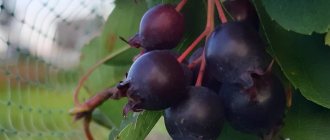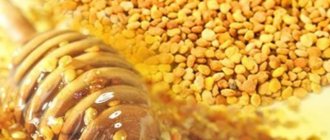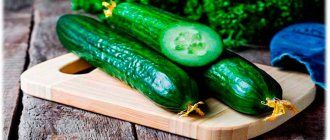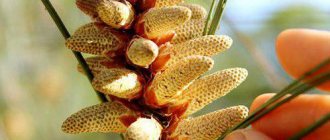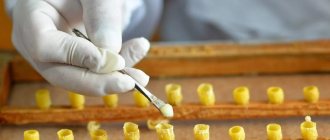Witloof chicory lettuce (Cichorium intybus L.) is a perennial plant from the Asteraceae family. It is cultivated as a biennial. By the end of the first season, the witloof grows a powerful rosette of leaves and a root crop, which is later used for forcing heads of cabbage or eaten. The leaf blades are large, with wide petioles. The root crop is elongated-conical in shape, white. The tubers are used to prepare a coffee drink, and the leaves are a healthy component of fresh salad; they are also boiled and stewed.
Flowering occurs in the second year. An erect flowering stem 1.2-1.3 m high appears. Small blue or white flowers are collected in an inflorescence-basket. The fruit is a ribbed achene. Seed germination lasts for 3-4 years.
The culture was developed at the end of the 19th century from chicory root. The name of the plant (Witloof) is translated from Flemish as “white leaf”. There are other names: white head, White leaf lettuce, Brussels chicory, lettuce endive.
Suitable place to grow endive lettuce
Salad chicory witloof growing from seeds in open ground
Illumination
To grow chicory witloof lettuce, you will need a well-lit area, cleared of weeds (especially malicious ones - sow thistle, wheatgrass).
Priming
The soil is nutritious (with a deep humus layer, containing a large amount of humus) with a pH of 6.5 and higher. Too light or heavy soil must be improved by adding compost or peat chips. Heavy clay soils with close groundwater are contraindicated.
It is important not to apply fertilizers with a high nitrogen content, as this will provoke an active growth of green mass to the detriment of the formation of high-quality root crops.
Predecessors
It should not be cultivated on the site after growing lettuce, parsley, tomatoes, carrots, and potatoes. The best predecessors are cabbage, cucumbers, and legumes.
Witloof sowing time
How to plant endive lettuce with seeds in the ground
Lettuce chicory is grown without seedlings. It will take 3-4 months for normal root crops to form. Seedlings are sown in late February-early March.
You can sow as soon as the soil warms up to 7-9 °C (depending on the region, this is the end of April-beginning of May, you can sow until the beginning of summer).
The optimal sowing time for consuming witloof in the summer is the first ten days of May, and for obtaining root crops for forcing - the third ten days of the same month.
Growing chicory salad from seeds in open ground
How to sow endive lettuce photo
The agricultural technology for sowing and growing chicory salad from seeds is reminiscent of the rules for sowing and caring for carrots. Witloof is sown in rows (distance between rows is 30-45 cm) or in two-line ribbons (20 cm between lines and 45 cm between ribbons).
The seeding depth should be 1-1.5 cm.
Dietary chicory salad growing from seeds
Expect emergence of seedlings in about 8 days. Loosen the soil and carry out the first thinning, leaving a distance of 7-8 cm between individual plants. Thin again until the leaves close (when a fairly large leaf rosette has developed), increasing the distance to 15-16 cm.
First of all, remove those plants whose leaf blades are pressed tightly to the ground - they have a tendency to set flowering stems prematurely.
Growing witloof from seeds to seedlings
Witloof is planted for seedlings in late February - early March. It is advisable to plant one seed at a time in the cells of the cassettes to avoid picking, but it is also possible in seedling boxes with subsequent picking into separate cups.
The seedlings are kept at a temperature no higher than 10°C, otherwise the witloof will produce flower shoots in the same season. It is best to sow endive lettuce in an unheated greenhouse. Watering needs moderate, bright, diffused lighting. Before planting in the ground, seedlings are hardened for 10-12 days.
Seedlings at the age of 30-35 days are transplanted by transshipment into open ground, keeping a distance of 30 cm between plants.
Growing conditions
For such an unpretentious crop as lettuce chicory, cultivation is limited to the implementation of conventional agrotechnical measures. You need to choose a suitable place for the crop, properly cultivate the soil, plant it in a timely manner and provide further care.
Site selection
Salad chicory is not too demanding on environmental conditions, but some factors are important for it:
- Illumination. The bed should be located in a place where the plants will be illuminated by the sun throughout the day. There should be no shading from objects or other plantings.
- The soil. A soil of medium density and enriched with organic matter with deep groundwater is required. Both too light and too heavy soils are undesirable, improvement of which is carried out by adding compost or peat, respectively. You cannot use a lot of nitrogenous fertilizers as fertilizers, since excess nitrogen causes increased growth of green mass, which deteriorates the quality of root crops, reduces immunity and keeping quality.
- Predecessors. It is best to choose beds where cucumbers, cabbage or legumes previously grew. Unfavorable predecessors are lettuce, parsley, carrots, tomatoes, and potatoes.
Related article:
When to harvest, how to collect and store carrots
You need to prepare your garden in the fall:
- loosen, wait until the weeds sprout, and then remove them;
- dig up with a bayonet while simultaneously applying fertilizer - 2 kg of humus, 1 cup of wood ash, 2 tbsp. l. limestone flour, 1 tbsp. l. potassium salt and superphosphate per 1 sq. m.
With the onset of spring warmth, you need to dig up the area again with a bayonet and add 50 g of nitrophoska.
Landing dates
Salad chicory is bred in two ways - by sowing seeds directly to a permanent place and through seedlings. Depending on this, the following planting dates are observed:
- seeds are sown in the soil when it warms up to at least 7°C (in regions with different weather conditions this period falls at the end of April - the first ten days of May, but sowing can continue until the end of spring);
- They begin to grow seedlings in the second half of February - the first ten days of May, choosing the timing also depending on the climatic characteristics of the area.
Related article:
How to feed garlic to prevent yellowing
Root vegetables ripen within 3–4 months, and greens that can be eaten appear around mid-summer.
Salad of apple, walnut and cottage cheese in chicory leaves
Sowing in open ground
For sowing crops, prepare shallow (up to 1.5 cm) furrows, placing them according to one of the following patterns:
- with equal row spacing of 35–40 cm;
- two-strip tapes - 20 cm between stripes and 40 cm between tapes.
Shoots should appear in 7–9 days. When they grow a little, they loosen the soil and at the same time thin out the plantings, creating a gap of 7 cm between the sprouts. Repeated thinning is carried out after the formation of a rosette, increasing the gap to 15 cm.
Growing seedlings
To obtain seedlings, use separate containers (disposable or peat cups) or common boxes. In the first case, one seed is planted in each cell, which eliminates the need for picking. In the second, the emerging seedlings will need to be planted in individual containers.
Related article:
What to feed raspberries
Seedling containers are installed in a room with the following conditions:
- good illumination with bright but diffused light;
- temperature up to 10°C (when grown in warmth, bolting will begin);
- moderate soil moisture.
1.5–2 weeks before planting in open ground, the seedlings are hardened - taken outside, first left for half an hour, and then gradually increase this time.
Transplantation to a permanent place is performed at the age of 1 month. The layout is the same as when sowing seeds.
Site preparation
Site preparation should begin in the fall. First, loosen it well to encourage the germination of weeds - remove them and treat them with a special preparation. After 10 days, dig to a depth of 25-30 cm and apply fertilizer. For 1 m² you will need: about 2 kg of manure or rotted compost, 2 tablespoons of dolomite flour, 1 tablespoon each of potassium salts and superphosphate, 1 glass of ash; for heavy loamy soils, you will additionally need 1 bucket of peat.
In early spring, when it is possible to enter the area, dig to the depth of a shovel and add 1 teaspoon of ammonium nitrate per 1 m².
How to care for Witloof endive lettuce
Caring for Brussels chicory is not difficult. Watering, loosening the soil, and fertilizing will be required.
Watering and loosening the soil
Water regularly, but moderately; in severe drought, more abundantly. With a lack of moisture, the leaves become coarser and acquire a bitter taste. It is preferable to water in the morning, avoid getting water on the leaves.
During the growing season, you should loosen the soil between the rows about 3-4 times; if the soil is heavy, loosen it after each watering or precipitation. It is especially important to loosen the soil well (to a depth of about 15 cm) before closing the leaves.
Top dressing
It is enough to feed a couple of times per season. Be sure to fertilize in early August. Use the solution: 1.5 tablespoons of nitrophoska per 10 liters of water (consumption per 3 m²).
Preparing for harvest
Three weeks before harvesting, the leaves of endive lettuce must be bleached if you plan to eat them. The outer leaves are connected at the top, tied and the bed with witloof is covered with black lutrasil until harvesting. If the leaves are not bleached, they will be very bitter.
Endive
Endive leaves can be eaten either white or green
Endive, unlike witloof, can be grown directly in the loggia. Seeds are sown in containers at any time of the year, deepening them 1 cm into the soil. Until shoots appear (5-8 days), the boxes should be kept in the dark and warm - at a temperature of 20-25 ° C. After this, they can be moved to a cooler place (16-18°C). In the cold season, it is usually enough to just put it in the loggia.
Endive loves sunlight very much. Therefore, if you grow a crop in winter, it is necessary to provide the plant with additional lighting for 12 or more hours a day. Seedlings can be planted approximately 15 days after emergence. You should take spacious pots, 15x15 cm in volume.
Carved endive leaves can be cut green periodically. To make the leaves turn white, cover the plants with black film or place them in an opaque bag 2-3 weeks before harvesting. When endive begins to harden, it loses some of its beneficial properties, so it is no longer worth eating it in this form - it is better to sow a new one.
Endive is also grown in the garden. It can be sown from April to July in several stages, then the harvest can be harvested continuously. This endive salad loves fertile soils with a neutral reaction. The seeds should not be distributed too tightly; after several thinnings, the distance between seedlings should be 25-30 cm, and between rows - 40-50 cm. In general, dense planting is acceptable, but in this case the rosettes should be cut off at a young age.
While the plants are still very tiny, they need to be watered very carefully: preferably by sprinkling. When the endive begins to grow actively, it is better to irrigate by pouring water between the rows and trying not to get it on the leaves. The soil should not be allowed to dry out, otherwise the endive will begin to coarse and become overly bitter. During the growth period, the plant needs two feedings. They can be carried out using complex mineral fertilizer (1 liter per sq.m.).
A few weeks before the endive harvest, it is recommended to cover the bed with black film. To prevent the plants from rotting or pests infesting them at this time, such a greenhouse should be periodically ventilated.
To force greenery in the off-season in autumn, the roots of plants sown in July must be dug up and placed in a box with peat, sawdust or soil. The height of the box should be at least 40-45 cm, and the layer of substrate should be about 15 cm. The rhizomes should be stored in a dark, cool place. When the need arises to grow endive, simply take a few roots from storage, plant them in pots with sand and leave them in a warm place. Leaves from forced plants should be cut before they begin to turn green.
Endive varieties: for home cultivation - Spring Lace, Kucheryavets, Monaco, Seagal; for open ground – Yellow curly, Green curly, Mossy.
Harvesting and storing witloof root vegetables
How to store the harvest of endive witloof salad photo of root vegetables
The maturity of root crops is indicated by reddening of the leaves - this is the first signal that harvest time has come. However, if the weather is warm, you can wait, then the root vegetables will fill out a little more and gain weight.
When harvesting root crops, it is very important not to damage the roots, so as not to provoke disease and rot of the root crops during storage. Before trimming the leaves and storing them in the cellar, the root crops should be dried, leaving them on the field for several days, covered with straw or in a pile with the leaves facing out. The leaves are cut at a height of 3-5 cm above the top of the root crop. To obtain an even planting level, the roots are also trimmed, keeping the root length to approximately 20 cm.
If the roots are forked, do not be upset: they can also be used for forcing, although the volume of the harvest may be slightly reduced.
When and how to dig witloof
Digging up Brussels chicory roots should be done in the fall before the onset of heavy frost (around the end of September). Pick a nice day. Dig not with a shovel, but with a garden fork. The tops are not cut off immediately. Carry out an inspection: rotten and damaged root crops should be disposed of; too large ones are also not suitable for storage. High-quality ones are placed in a pile with the leaves facing out and stored for 7-8 days. This is done to ensure that nutrients flow from the leaves to the roots.
How to dry and trim
How to harvest endive lettuce photo trimmings
But if the root crops are damaged by autumn frosts after digging, they will not be stored well in the future. It is better to keep it in a cool, dry room with good ventilation until the leaf blades wither. Then cut the tops 3-5 centimeters above the neck of the root crop to avoid damage to the apical buds. Sort the root vegetables by size: large (over 5 cm in diameter), medium (3-5 cm), small (up to 3 cm in diameter).
How to store
Witloof root vegetables prepared for storage
Then place the root vegetables horizontally in boxes, sprinkle with dry sand, sawdust or peat. You can use sugar or flour bags, leaving the top open for ventilation. The optimal air temperature for storing witloof is the range from 0 to +1 °C. Alternatively, place in the vegetable section of the refrigerator (although the temperature is higher there).
Beneficial properties of endive
It is very interesting that endive is closely related to... dandelion, and their chemical composition is very similar. Among all green vegetables, endive is one of the richest foods in carotene content. It is also useful in terms of vitamin C, calcium, chlorine, iron, phosphorus, potassium, and sulfur content.
Endive contains a lot of B vitamins: folic acid, pantothenic acid (vitamin B5), pyridoxine (vitamin B6), thiamine (vitamin B1) and niacin (B3). These vitamins are extremely beneficial for the nervous system. They are also involved in many important metabolic processes.
Inulin in salad helps regulate substances in the human body. Eating salad has a beneficial effect on the functioning of the liver and cardiovascular system. Its leaves also contain the glucoside intibin, which has a beneficial effect on the nervous system and blood circulation, increases appetite and due to which they have a bitter taste. It helps reduce blood glucose and cholesterol levels in diabetics and obese patients.
Curly endive contains nutrients that are necessary for the optical system of the eyes. Drinking endive juice mixed with carrot, parsley and celery juice can restore some vision defects. The juice also supplies the muscular system of the eyes. Drinking the juice for several weeks will help restore your vision.
Forcing endive lettuce
Forcing endive lettuce in a box photo
Before planting, vernalization is carried out about a week: root crops are stored at a temperature of 32-34 degrees and high humidity. This will wake up the witloof and allow you to quickly get fresh, juicy leaf heads. If you plant directly from storage, the green harvest will be much smaller. For forcing, select suitable root crops: without horizontal rosettes of leaves and peduncles.
You will also need:
- a light-proof container 40-50 cm high (a wooden box is perfect, but in room conditions the container should be waterproof - a plastic container, a bucket);
- non-woven black covering material or lightproof cover;
- peat or sand to fill the container.
Pour soil onto the bottom, place the root crops close to each other, fill the cracks and voids with the same substrate. The tops should be at the same level - too long ones can be trimmed.
Having reached the middle of the container in height, water the root vegetables, then add soil to the very top.
Cover the top with non-woven material or a lid - forcing should take place in the dark so that the heads of cabbage remain whitish. If they turn green, the taste will become bitter.
Maintain the air temperature within 7-8 °C, after 10 days move to a warmer place - the air temperature is in the range of 14-18 °C. This way the forcing process will speed up, but the heads of cabbage will be looser. Forcing lasts about 15-20 days. Cut off the finished heads of cabbage with the top of the root so that they do not crumble. When stored in the refrigerator, they stay fresh for about 3 weeks.
Forcing endive witloof lettuce photo
Another method of forcing. A wooden box is buried in a greenhouse or hotbed. The tubers are placed close to each other, watered and covered with a layer of soil of about 25 cm (sand, peat, ordinary garden soil, sawdust) or covered with film. The air temperature should be about 10 °C. The heads of cabbage will reach the surface of the covering layer in 25-30 days.
To get fresh witloof leaves in early spring, forcing is carried out in open ground. In mid-autumn, root crops are planted in beds and covered with a layer of peat about 20 cm.
Winter forcing
Forcing chicory begins 4 weeks after harvesting the root crops and continues throughout the winter. A few days before planting, they are vernalized - transferred to a room with a temperature of 34°C and high humidity. This procedure is necessary so that the root crops “wake up” and quickly sprout. When planting directly from a cool cellar, the yield will be much lower.
Next, the event is carried out according to the following scheme:
- choose a suitable light- and moisture-proof container, pour the soil mixture or sawdust into it in a layer of 10 cm;
- root crops are trimmed so that they are all the same in height, placed tightly in a container, watered and completely covered with soil mixture;
- cover with a thick dark film or lid so that the plantings are kept out of light - then the heads of cabbage will be white and tasty (under the influence of light they turn green and begin to taste bitter);
- the process should take place at 7°C for 10 days, then the containers are transferred to a room with a temperature of 15–18°C.
The duration of forcing is 2–3 weeks. In this way, the crop can be grown from October to March.
Cut off the heads of cabbage with a piece of the root vegetable so that they do not fall apart. But it is recommended to leave the growing point untouched, then several crops can be harvested from one root.
After cutting, fresh salad chicory can be stored in the refrigerator for up to three weeks. You cannot leave it in the light, otherwise the leaves will turn green and become bitter. The root crops remaining from distillation or unsuitable for it are dried, crushed and a drink reminiscent of coffee is prepared from the powder.
Varieties of endive witloof lettuce with photos and names
Domestic varieties:
Endive salad Pala Rossa photo and description
The variety is grown both without seedlings and in seedlings. Seedlings are sown in February-March. Seeds are planted in the ground in April-June. 3 weeks before harvesting, the leaves are tied and covered with opaque agrofibre for bleaching. If this is not done, the leaves will become very bitter.
Chicory salad Cone photo
Cone - white root vegetables, 15-20 cm long, diameter - about 3.5 cm. The head is elliptical in shape with juicy pulp. The period from the appearance of mass shoots to technical maturity is 98-114 days. The forcing period is 17-30 days. Forcing is carried out in December-January in a dark room with or without covering with soil substrate. When forcing, maintain a constant air temperature of no lower than 7 °C and no higher than 16 °C. Heads of cabbage are harvested when they reach a height of 15 cm.
Chicory salad Rocket
Rocket - the shape of the root crop is elongated-conical, gaining weight up to 250 g. The head of cabbage is elongated-ovoid in shape, up to 12 cm high, diameter - 5 cm, dense. The pulp weight is 85-100 g. It has a longer ripening period: the period from the appearance of sprouts to technical maturity is 130-155 days, the forcing period is about 30 days.
Foreign varieties:
- For early forcing: Exterella, Express.
- For autumn-winter: Mitado, Danish Witloof.
- For later: Tardivo, Blanca, Productiva.
Through hybridization, witloof was developed with red and yellow heads.
Endive salad: characteristics and varieties
Chicory lettuce belongs to the Aster family of the wild chicory genus (Cycorium). There are several forms belonging to the same botanical species, which form a developed leaf rosette:
- Escarole (Cyrconium endivia latifolia) - a rosette formed from whole, petiolate leaves with straight or wavy edges. Escarole lettuce (white chicory) is a biennial crop that produces a large, loose head of leaves, the number of which reaches 85 or more. The shape of the leaves is rounded and wide, the plate is solid with smooth or wavy edges. Interestingly, large leaves are formed in late-ripening varieties. The color of lettuce leaves depends on the varietal group and varies from pale yellow to rich green. The roots are not large, woody and branched. 2-3 months after the appearance of the first shoots, a tall, even peduncle is formed, and after another month the lettuce begins to bloom pink or blue.
- Endive (Cyrconium endivia crispa) - has strongly dissected, curly leaves.
- Witloof (Cyrconium intybus) is a perennial crop that, by the end of the first year of life, forms not only lush rosettes of edible leaves, but also fleshy white roots suitable for forcing winter bleached lettuce leaves. The following year the plant blooms with bluish flowers, producing long flower arrows. Varietal groups of witloof have differences in the timing of forcing and the color of the leaves, which varies from white to red and yellow shades.
Endive lettuce is considered a biennial or perennial crop, however, it is often grown as an annual. The plant forms a developed basal rosette of leaves and a branched root system. The stem leaf is sessile with ears and covers the stem. Chicory lettuces have erect stems that reach a meter in height. It blooms with light blue flowers, which are collected in basket-like inflorescences. In escarole they are large, and in endive they are small.
Plants produce fruits that look like silver-gray ribbed elongated achenes.
The culture is resistant to frost and can withstand temperature drops of up to three degrees. But it should be remembered that low temperatures during early spring planting provoke an early release of color. Varieties with pronounced red pigmentation of leaves are more resistant to frost.
It is recommended to grow chicory salads in spring or autumn, when daylight hours are short enough. In longer summer daylight hours, color formation accelerates. Fertile soil with high drainage capacity is suitable for cultivation.
Culinary tricks for preparing endive salad
If the endive salad is bitter
To remove bitterness, witloof leaves are placed in boiling water for 1 minute or soaked in salted water for 2-3 hours.
Cooking boiled and stewed witloof
How to prepare Witloof endive salad photo
The heads of cabbage are cut, sprinkled with grated cheese and stewed in butter or milk; topped with meat sauce and baked with ham and cheese.
How to prepare and eat endive salad
The roots, like the leaves of the plant themselves, are characterized by a special bitter taste. That's why:
- Roasted chicory root powder is used to make diet coffee;
- juicy leaves seasoned with lemon juice and olive oil are added to salads;
- roots and leaves become an excellent side dish for baked meat or fish;
- sprouts and rough outer leaves of chicory salad are added to vegetarian soups and casseroles;
- the upper green parts of young endive are well suited as a spice for stewing and making a dressing;
- Chicory salad is often included in sauces.
To give the leaves freshness, it is recommended to put them in ice water for literally 15–20 minutes.
Before cooking, rinse the lettuce leaves well in running water. Throw away any that are yellowed or discolored. Trim off the tough bottom ends.
It can be used in salads, added to stews, stewed, cooked soup and green cabbage soup.



